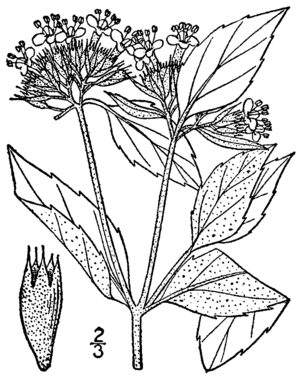Hoary mountainmint facts for kids
Quick facts for kids Hoary mountainmint |
|
|---|---|
 |
|
| Pycnanthemum incanum var. incanum | |
| Scientific classification | |
| Genus: |
Pycnanthemum
|
| Species: |
incanum
|
| Synonyms | |
|
|
The Hoary mountainmint (scientific name: Pycnanthemum incanum) is a cool plant that belongs to the mint family. It's also known as "mountain mint," "wild basil," or "hoary basil." This plant is a perennial, which means it lives for more than two years and comes back each growing season.
Contents
Where Hoary Mountainmint Grows
This plant is found all over the Eastern United States and even up into Ontario, Canada. It likes to grow in places with rocky, gravelly, or sandy soil. You can often spot it in woods, thickets (which are like dense bushes), fields, and on hills.
Protecting This Plant
Sadly, the hoary mountainmint is an endangered species in some places. This means there aren't many of them left in the wild. For example, it's endangered in Vermont, New Hampshire, and in Ontario, Canada. In Ontario, there are only two groups of these plants left!
Because it's endangered, people are working to protect it. The Ontario Ministry of Natural Resources has a plan to watch over these last groups of plants to help them survive and grow.
What Hoary Mountainmint Looks Like
Hoary mountainmint can grow to be about 2 to 4 feet (0.6 to 1.2 meters) tall and up to 4 feet (1.2 meters) wide. Its stems are covered with a soft, whitish fuzz, which is why it's called "hoary."
This plant is a strong grower and can spread easily using long underground stems called rhizomes.
Its white flowers bloom from July to September. The name Pycnanthemum comes from Greek words meaning "dense flower-clusters," which describes how its flowers grow close together. These flowers are very popular with many different pollinators, like butterflies, moths, honeybees, and even some types of wasps.
Different Types of Hoary Mountainmint
There are a couple of slightly different types, or varieties, of hoary mountainmint:
- Pycnanthemum incanum var. incanum - This one is found in Ontario and the eastern US.
- Pycnanthemum incanum var. puberulum - This type grows in places like West Virginia, Alabama, and North and South Carolina.
Uses of Hoary Mountainmint
When you crush the leaves of the hoary mountainmint, they give off a strong, fresh minty smell. Because of this, people often use the leaves to add flavor to teas.
Traditional Uses
Historically, some Native American tribes used hoary mountainmint for different purposes.
The Choctaw people, for example, would mash the leaves and mix them with warm water. They would drink this water or pour it over their heads to help with headaches. For people who were often sick, a doctor might blow water with mashed leaves onto the patient's head, back, and chest. The patient would then bathe in the medicine before sunrise.
The Koasati tribe used mashed leaves in water to help with laziness. They would wash their face with the cold water and drink it. For nosebleeds, they would wet the plant and put it into the nostrils to stop the bleeding. They also boiled the roots with Black Willow to make a drink that helped with headaches.
Besides human uses, large mammals also eat hoary mountainmint, so it's a food source for them in the wild.

